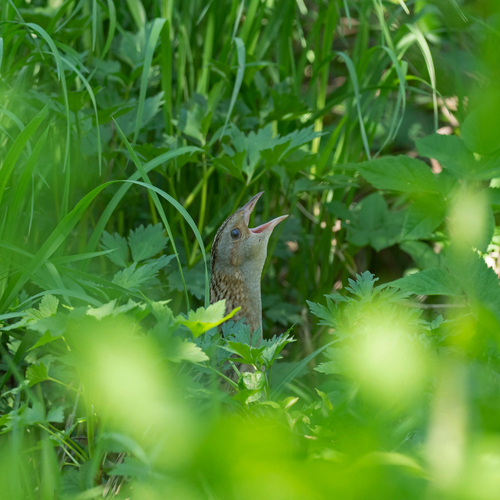
Much more often heard, often at night, than seen, the Corncrake was once found in every county in Britain and Ireland – that’s about 150 years ago. But it made the mistakes of nesting in grasslands and needing to produce lots of young every year to survive. Corncrakes are short-lived – only 25-30% of adults survive to the next year. So they need to produce lots of young which means having more than one successful nesting attempt each year. Corncrakes will keep laying eggs and producing chicks through the summer and into August. This has worked well for thousands of years but as mechanisation of hay cutting, loss of hay meadows and silage making have increased it has become more and more difficult for Corncrakes to produce enough young to survive (their ‘r’, that concept with which we have become more familiar thanks to a certain virus, has to be >1 and it has dropped to <1 in most places in the UK).
Corncrakes stay in the long grass and are rarely seen – but if they are around, you may well hear them. I usually pay a visit to the RSPB Nene Washes at this time of year, one evening, sometimes to avoid the Eurovision Song Contest on TV, to listen for Corncrake. The Nene washes has Corncrakes thanks to them being reintroduced there but otherwise you will have to head to the the Hebrides or Western Isles, or maybe Orkney, to stand much of a chance of hearing them in the UK. Otherwise, head east to a part of Europe whose agriculture looks primitive and you’ll find Corncrakes.
When you are in the right place you may wonder whether this was a song worth hunting down. The scientific name for the Corncrake is Crex crex and that’s a pretty good rendition of its rasping song.
Here are Corncrakes singing from Sweden (in 1965):
… and from Austria:
… and from Lewis, Scotland, UK:
Crex crex!
I used to drive past a small place called Tempsford, just off the A1 and by the River Ouse, on my commute to Sandy. In the first book on the birds of Bedfordshire in the early 1900s, Tempsford’s Corncrakes were mentioned as keeping the residents awake with their incessant calling. No longer.
[registration_form]
A ranger friend told me that there are still people alive in Falkirk District who remember hearing corncrake here when they were young. One of those rare facts that are literally ‘mind blowing’. I expect the same’s true for many other parts of the UK in spite of us thinking for decades now the corncrake is a bird which is limited to the very fringes of the country. When the other side are doing their best to pretend that the intensification of agriculture has nothing to do with the loss of curlew and lapwing and it’s all down to predation it’s good to bring up the corncrake. Why if it’s due to buzzards, crows and foxes didn’t the ground nesters start declining at the same time? The corncrake went downhill with a previous set of changes to farming the others with subsequent ones which compounded the problems so even the more resilient species couldn’t cope anymore. I’ve seen the latest ‘advances’ myself and it’s hard to see how as much as a vole or bumblebee could survive in many fields. It would be great to see more local reintroductions of species which aren’t nationally extinct, but are missing from most of their old haunts – I’ve still to see/hear my first corncrake which must go for the vast majority of us.
Les – there will be a great many people in Northern ireland who can remember Corncrakes in the fields of their youth – but they’ve gone from there too. As progress marches on it stamps out some wildlife.
Mark I was just about to comment that an awful lot of people in NI remember the corncrake and curlew as being abundant through the countryside. I hear the stories from any older rural generation I speak to, including my own father. He grew up in a semi-upland farm in the depths of Tyrone in the 50s and has many stories of incessant corncrakes, their chicks running through the yard, curlew and grouse on the hill, yellowhammer in every hedge, vast flocks of plover and murmurations of starlings.
Unfortunately the countryside of NI has in record time become one enormous sterile green desert, its only purpose to produce beef, milk and lamb. The loss of the small pockets of high value habitat continues unabated and nobody seems very willing to address it. Certainly biodiversity and environment issues are the very last thing on the minds of the Northern Irish Assembly who only like to fight over green and orange issues with any real passion.
The corncrake also went extinct in Northern Ireland in record time. Fortunately, they have just about managed to recolonise Rathlin Island, and still hang on in parts of Donegal. I dream of a new agricultural and land use model which will bring these lost sounds and sights of my fathers’ youth back into reality.
I’ve only ever heard one in the UK, although I’ve seen several migrants, all in autumn.
In 2002 in north east Poland it was a bird you heard almost constantly if not in woodland. One wonders if joining the EU is putting paid to them there too. I really do hope not.
Extinct as a breeding bird in West Glamorgan from about 1950 – presumably due to intensification of agriculture during and after ‘dig for victory’ – so there must be a few people still living here who heard it locally.